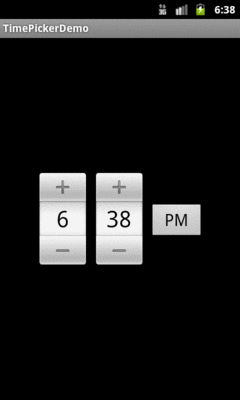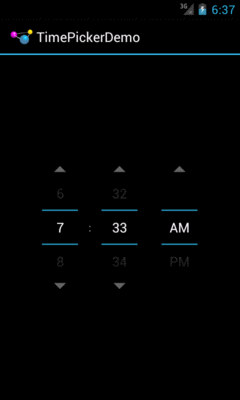
Figure 1056: Android 2.3.3
Just as DatePicker allows the user to pick a date,
TimePicker allows the user to pick a time. This widget is a bit simpler
to use, insofar as you do not have the option of the integrated
CalendarView as you do with DatePicker. In other respects, TimePicker
follows the patterns established by DatePicker.
Note that TimePicker only supports hours and minutes, not seconds
or finer granularity.
With DatePicker, the act of supplying an OnDateSetListener also required
you to supply the year/month/day to use as a starting point. TimePicker
is more intelligently designed: setting the OnTimeSetListener is
independent from adjusting the hour or minute.
As with DatePicker, TimePicker works well with Calendar and
GregorianCalendar, in
terms of setting and getting the hour/minute/second from the
TimePicker and converting it into something you can use in your code.
There is a bug
in which your OnTimeSetListener
is not invoked when the user changes between AM and PM when viewing
the TimePicker in 12-hour display mode.
The sample project can be found in
WidgetCatalog/TimePicker.
Layout:
<?xml version="1.0" encoding="utf-8"?>
<LinearLayout xmlns:android="http://schemas.android.com/apk/res/android"
android:layout_width="match_parent"
android:layout_height="match_parent"
android:orientation="vertical"
android:gravity="center_vertical">
<TimePicker
android:id="@+id/picker"
android:layout_width="match_parent"
android:layout_height="wrap_content"/>
</LinearLayout>
Activity:
package com.commonsware.android.wc.timepick;
import android.app.Activity;
import android.os.Bundle;
import android.widget.TimePicker;
import android.widget.TimePicker.OnTimeChangedListener;
import android.widget.Toast;
import java.util.Calendar;
public class TimePickerDemoActivity extends Activity implements
OnTimeChangedListener {
@Override
public void onCreate(Bundle savedInstanceState) {
super.onCreate(savedInstanceState);
setContentView(R.layout.main);
TimePicker picker=(TimePicker)findViewById(R.id.picker);
picker.setOnTimeChangedListener(this);
}
@Override
public void onTimeChanged(TimePicker view, int hourOfDay, int minute) {
Calendar then=Calendar.getInstance();
then.set(Calendar.HOUR_OF_DAY, hourOfDay);
then.set(Calendar.MINUTE, minute);
then.set(Calendar.SECOND, 0);
Toast.makeText(this, then.getTime().toString(), Toast.LENGTH_SHORT)
.show();
}
}

Figure 1056: Android 2.3.3

Figure 1057: Android 4.0.3

Figure 1058: Android 5.0
